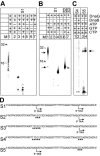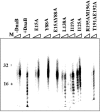In the Bacillus stearothermophilus DnaB-DnaG complex, the activities of the two proteins are modulated by distinct but overlapping networks of residues
- PMID: 16452437
- PMCID: PMC1367256
- DOI: 10.1128/JB.188.4.1534-1539.2006
In the Bacillus stearothermophilus DnaB-DnaG complex, the activities of the two proteins are modulated by distinct but overlapping networks of residues
Abstract
We demonstrate the primase activity of Bacillus stearothermophilus DnaG and show that it initiates at 3'-ATC-5' and 3'-ATT-5' sites synthesizing primers that are 22 or 23 nucleotides long. In the presence of the helicase DnaB the size distribution of primers is different, and a range of additional smaller primers are also synthesized. Nine residues from the N- and C-terminal domains of DnaB, as well as its linker region, have been reported previously to affect this interaction. In Bacillus stearothermophilus only three residues from the linker region (I119 and I125) and the N-terminal domain (Y88) of DnaB have been shown previously to have direct structural importance, and I119 and I125 mediate DnaG-induced effects on DnaB activity. The functions of the other residues (L138, T191, E192, R195, and M196) are still a mystery. Here we show that the E15A, Y88A, and E15A Y88A mutants bind DnaG but are not able to modulate primer size, whereas the R195A M196A mutant inhibited the primase activity. Therefore, four of these residues, E15 and Y88 (N-terminal domain) and R195 and M196 (C-terminal domain), mediate DnaB-induced effects on DnaG activity. Overall, the data suggest that the effects of DnaB on DnaG activity and vice versa are mediated by distinct but overlapping networks of residues.
Figures




Similar articles
-
Allosteric regulation of the primase (DnaG) activity by the clamp-loader (tau) in vitro.Mol Microbiol. 2009 Apr;72(2):537-49. doi: 10.1111/j.1365-2958.2009.06668.x. Mol Microbiol. 2009. PMID: 19415803 Free PMC article.
-
DnaG interacts with a linker region that joins the N- and C-domains of DnaB and induces the formation of 3-fold symmetric rings.Nucleic Acids Res. 2004 Jun 1;32(10):2977-86. doi: 10.1093/nar/gkh628. Print 2004. Nucleic Acids Res. 2004. PMID: 15173380 Free PMC article.
-
Mapping protein-protein interactions within a stable complex of DNA primase and DnaB helicase from Bacillus stearothermophilus.Biochemistry. 2000 Jan 11;39(1):171-82. doi: 10.1021/bi9918801. Biochemistry. 2000. PMID: 10625492 Free PMC article.
-
The bacterial helicase-primase interaction: a common structural/functional module.Structure. 2005 Jun;13(6):839-44. doi: 10.1016/j.str.2005.04.006. Structure. 2005. PMID: 15939015 Free PMC article. Review.
-
Regulation of bacterial priming and daughter strand synthesis through helicase-primase interactions.Nucleic Acids Res. 2006;34(15):4082-8. doi: 10.1093/nar/gkl363. Epub 2006 Aug 25. Nucleic Acids Res. 2006. PMID: 16935873 Free PMC article. Review.
Cited by
-
Staphylococcus aureus helicase but not Escherichia coli helicase stimulates S. aureus primase activity and maintains initiation specificity.J Bacteriol. 2006 Jul;188(13):4673-80. doi: 10.1128/JB.00316-06. J Bacteriol. 2006. PMID: 16788176 Free PMC article.
-
Allosteric regulation of the primase (DnaG) activity by the clamp-loader (tau) in vitro.Mol Microbiol. 2009 Apr;72(2):537-49. doi: 10.1111/j.1365-2958.2009.06668.x. Mol Microbiol. 2009. PMID: 19415803 Free PMC article.
-
Structural Insight into the Specific DNA Template Binding to DnaG primase in Bacteria.Sci Rep. 2017 Apr 6;7(1):659. doi: 10.1038/s41598-017-00767-8. Sci Rep. 2017. PMID: 28386108 Free PMC article.
-
DnaG Primase-A Target for the Development of Novel Antibacterial Agents.Antibiotics (Basel). 2018 Aug 13;7(3):72. doi: 10.3390/antibiotics7030072. Antibiotics (Basel). 2018. PMID: 30104489 Free PMC article. Review.
-
Domain swapping reveals that the C- and N-terminal domains of DnaG and DnaB, respectively, are functional homologues.Mol Microbiol. 2007 Mar;63(6):1629-39. doi: 10.1111/j.1365-2958.2007.05617.x. Mol Microbiol. 2007. PMID: 17367384 Free PMC article.
References
-
- Bhattacharyya, S., and M. A. Griep. 2000. DnaB helicase affects the initiation specificity of Escherichia coli primase on single-stranded DNA templates. Biochemistry 39:745-752. - PubMed
-
- Chang, P., and K. J. Marians. 2000. Identification of a region of Escherichia coli DnaB required for functional interaction with DnaG at the replication fork. J. Biol. Chem. 275:26187-26195. - PubMed
-
- Corn, J. E., P. J. Pease, G. L. Hura, and J. M. Berger. 2005. Crosstalk between primase subunits can act to regulate primer synthesis in trans. Mol. Cell 20:391-401. - PubMed
-
- Fang, L., M. J. Davey, and M. O'Donnell. 1999. Replisome assembly at oriC, the replication origin of E. coli, reveals an explanation for initiation sites outside an origin. Mol. Cell 4:541-553. - PubMed
Publication types
MeSH terms
Substances
Grants and funding
LinkOut - more resources
Full Text Sources
Research Materials

